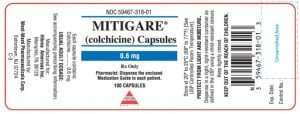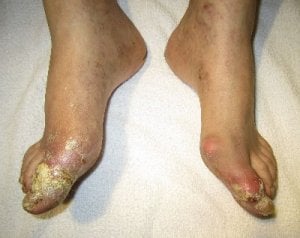“When is the best time to check uric acid levels?” is a frequent question on the gout forums. The easy answer is “first thing in the morning,” but there is more to it than that.
The most important factor is the reason for testing. In most cases, we simply want an accurate measure of current uric acid levels. For that, it is best to test at the same time each day. Note that for most people, the question is about testing at home using your own uric acid test kit. However, even for doctor’s testing, it is best to arrange appointments at roughly the same time. As I described in How Your Uric Acid Level Changes, uric acid levels vary naturally through the day. If we test at the beginning of the day, before the first meal, then many of these natural variances will be eliminated.
The issue of natural variations also means that you should never get obsessed with complete accuracy. A few percentage points of variation is expected. If your reading is 4.5 mg/dL one day, and 5.2 the next day, there is no cause for alarm. It is best to average your last three results. If that average is 5 mg/dL or below, you are safe. If it lies between 5 and 6, you should continue testing, but not worry too much, unless you are exposed to prolonged cold. A three reading average above 6 is a warning, and you should discuss this with your doctor as soon as you can.
One important factor is to be wary of false results. This is most likely with home testing, but can also happen with lab tests. If a test result is abnormally high or low, then it is best ignored. You should retest as soon as possible. For home testing:
- Wash and dry thoroughly before testing
- Be as consistent as possible
- Pay careful attention to blood droplet size
Reasons To Check Uric Acid Levels
Now, I have explained about testing routines for the usual reasons, let’s look at other reasons why you might want to test uric acid levels in your blood.
Apart from pure curiosity, many gout sufferers get home test meters to try and measure the effects of lifestyle changes. The usual reason is to try and determine if a particular food item, or dietary supplement, has any effect on uric acid.
Digestion rates vary from person to person, but usually, the maximum effect is after 2 hours. If you want to be very meticulous, you could take a reading before you eat, then every 30 minutes until you notice no further effect. Bearing in mind that natural variations may impact those tests, you should soon determine your personal profile. If this is 90 minutes, 150 minutes, or something else, you can use that time for future experiments. This sounds like a lot of effort to me, but if you are the type of person who likes to investigate the facts, this will give you your best chance of seeing how certain foods affect your uric acid levels. Unfortunately, this is not quite as relevant as it might appear.
Effects Of Uric Acid Levels
Uric acid by itself is quite harmless. It may play a part in pain signalling pathways, but current research has not yet explained why this happens, if at all. Gout pain does not come from uric acid in your blood, which is what you are measuring when you take a uric acid test. The pain comes from uric acid crystals.
To be precise, the pain comes from our immune system reaction to uric acid crystals. These crystals grow slowly over many months. They cause gout attacks when they first form, but they do not disappear. Our immune system coats the crystals with sacrificial white blood cells. If uric acid concentration falls, these crystals can start to dissolve. When this happens, the immune system coating will fall away, and exposed crystals might induce another gout attack. I’ve written more on this in my explanation of why allopurinol can cause gout attacks. Though that is specifically about allopurinol, the problem with dissolving uric acid crystals can happen when uric acid concentrations fall by any means.
You can see that we have a situation where crystals form slowly when uric acid is high. Once formed, they can cause repeat attacks quickly when uric acid is low. All this means that measuring the effect of certain foods on uric acid levels is quite pointless unless you recognize the long term goal of gout management.
Short term fluctuations in uric acid can certainly cause gout flares, but the only way to stop that is to maintain uric acid at 5 mg/dL or below. For most people, it will not matter if uric acid rises above that for an hour or so after a meal. If your kidneys are working properly, they will excrete the excess uric acid before it has time to form crystals.

Best Time To Check Uric Acid Levels
Rather than measuring immediate effects of food items, it is much safer to measure the overall effect of total diet changes on a daily basis. For that, we go back to the start of this article, and take a single daily, weekly, or monthly reading. The best time to check uric acid levels then returns to being “first thing in the morning.” You can adjust your diet for a week, then compare readings before and after your changes. This gives a much more useful reading than the temporary high two hours after a meal.
Leave Best Time To Check Uric Acid Levels to browse the Uric Acid Levels guidelines.
Best Time To Check Uric Acid Levels Related Topics
Please remember: to find more related pages that are relevant to you, use the search box near the top of every page.
Common Terms: test, Uric Acid Levels
Other posts that include these terms:
- Uric Acid Levels: Safe or Dangerous?
- Starting Allopurinol – Dosing Guidelines
- What is the purpose of Uric Acid Test?
- How Your Uric Acid Level Changes
- Uric Acid Concentration Conversion
- Uric Acid Test Kit
- Dangerous Uric Acid Levels
Please give your feedback
Did this page help you? If yes, please consider a small donation. Your donations help keep GoutPal's gout support services free for everyone.
If not, please tell me how I can improve it to help you more.
- YouTube
- The gout forums.










